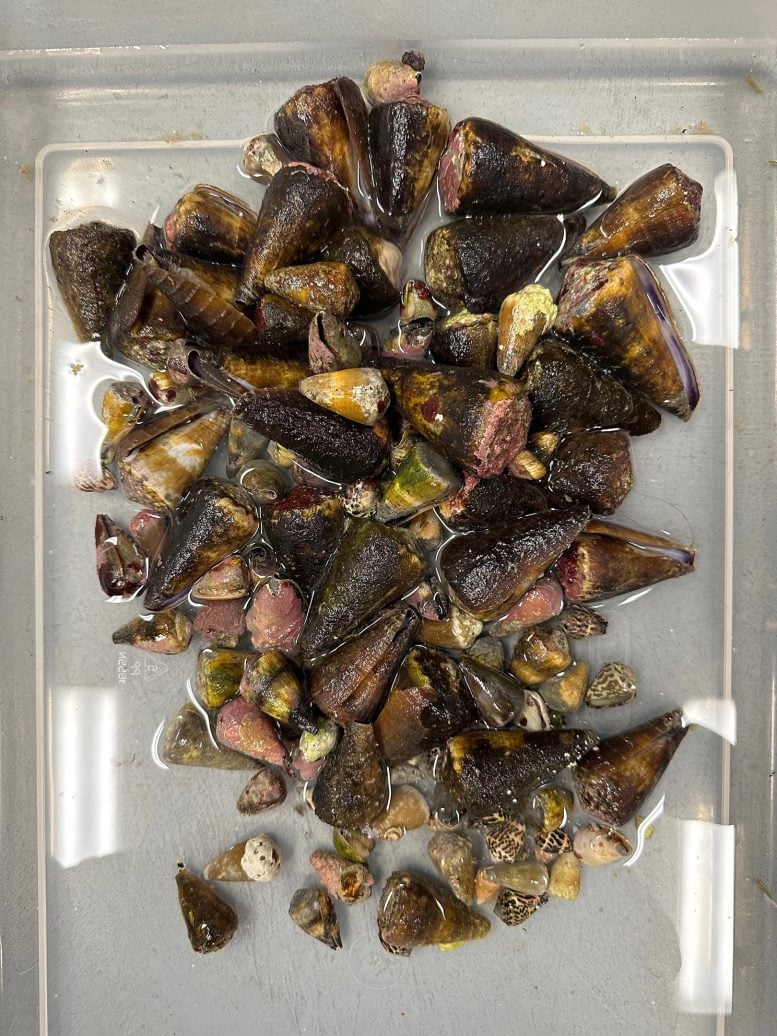Cone snail venom contains consomatin, a toxin that could lead to better, longer-lasting drugs for diabetes and hormone-related diseases by mimicking somatostatin.
A new study published in The somatostatin-like toxin the researchers identified could provide invaluable insights into new medications for diabetes and hormone disorders. Somatostatin acts like a brake pedal for many processes in the human body, preventing blood sugar, various hormones, and many other important molecules from rising to dangerously high levels. The researchers found the cone snail toxin, called consomatin, works similarly, —but consomatin is more stable and specific than the human hormone, which makes it a promising blueprint for drug design. By measuring how consomatin interacts with somatostatin’s targets in human cells in a dish, the researchers found that consomatin interacts with one of the same proteins that somatostatin does. But while somatostatin directly interacts with several proteins, consomatin only interacts with one. This fine-tuned targeting means that the cone snail toxin affects hormone levels and blood sugar levels but not the levels of many other molecules. In fact, the cone snail toxin is more precisely targeted than the most specific synthetic drugs designed to regulate hormone levels, such as drugs that regulate growth hormone. Such drugs are an important therapy for people whose bodies overproduce growth hormones. Consomatin’s effects on blood sugar could make it dangerous to use as a therapeutic, but by studying its structure, researchers could start to design drugs for endocrine disorders that have fewer side effects. Consomatin is more specific than top-of-the-line synthetic drugs—and it also lasts far longer in the body than the human hormone, thanks to the inclusion of an unusual amino Finding better drugs by studying deadly venoms may seem unintuitive, but Helena Safavi, PhD, associate professor of biochemistry in the Spencer Fox Eccles School of Medicine (SFESOM) at the University of Utah and the senior author on the study, explains that the toxins’ lethality is often aided by pinpoint targeting of specific molecules in the victim’s body. That same precision can be extraordinarily useful when treating disease. “Venomous animals have, through evolution, fine-tuned venom components to hit a particular target in the prey and disrupt it,” Safavi says. “If you take one individual component out of the venom mixture and look at how it disrupts normal physiology, that pathway is often really relevant in disease.” For medicinal chemists, “it’s a bit of a shortcut.” Ho Yan Yeung, PhD, first author on the study, hunts for venomous sea snails in the shallow reefs of Palau. Credit: Safavi Lab Consomatin shares an evolutionary lineage with somatostatin, but over millions of years of evolution, the cone snail turned its own hormone into a weapon. For the cone snail’s fishy prey, consomatin’s deadly effects hinge on its ability to prevent blood sugar levels from rising. And importantly, consomatin doesn’t work alone. Safavi’s team had previously found that cone snail venom includes another toxin that resembles “We think the cone snail developed this highly selective toxin to work together with the insulin-like toxin to bring down blood glucose to a really low level,” says Ho Yan Yeung, PhD, a postdoctoral researcher in biochemistry in SFESOM and the first author on the study. The fact that multiple parts of the cone snail’s venom target blood sugar regulation hints that the venom could include many other molecules that do similar things. “It means that there might not only be insulin and somatostatin-like toxins in the venom,” Yeung says. “There could potentially be other toxins that have glucose-regulating properties too.” Such toxins could be used to design better diabetes medications. It may seem surprising that a snail is able to outperform the best human chemists at drug design, but Safavi says that the cone snails have evolutionary time on their side. “We’ve been trying to do medicinal chemistry and drug development for a few hundred years, sometimes badly,” she says. “Cone snails have had a lot of time to do it really well.” Or, as Yeung puts it, “Cone snails are just really good chemists.” Reference: “Fish-hunting cone snail disrupts prey’s glucose homeostasis with weaponized mimetics of somatostatin and insulin” by Ho Yan Yeung, Iris Bea L. Ramiro, Daniel B. Andersen, Thomas Lund Koch, Alexander Hamilton, Walden E. Bjørn-Yoshimoto, Samuel Espino, Sergey Y. Vakhrushev, Kasper B. Pedersen, Noortje de Haan, Agnes L. Hipgrave Ederveen, Baldomero M. Olivera, Jakob G. Knudsen, Hans Bräuner-Osborne, Katrine T. Schjoldager, Jens Juul Holst and Helena Safavi-Hemami, 20 August 2024, Nature Communications.
Blueprint for Better Drugs


Learning from Cone Snails

Evolutionary Insights from Cone Snails
DOI: 10.1038/s41467-024-50470-2




















Discussion about this post